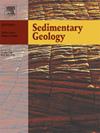Late Paleozoic coastal plain paleosols: Geochemical insights into soil genesis, provenance, and paleoclimate within paleoequatorial Pangea, Paradox Basin, USA
IF 2.9
2区 地球科学
Q1 GEOLOGY
引用次数: 0
Abstract
Studies of ancient drylands can enhance our understanding of ecosystem responses to changing climate, but reconstructing deep-time dryland environments using paleosols is challenging because these fossil soils are often weakly developed and many proxies are not equilibrated to past climate. Paleosols from the uppermost Honaker Trail Formation and lower Cutler beds (Rico and Halgaito Formations) span the Pennsylvanian-Permian transition within the Paradox Basin of southeast Utah (USA) and are an ideal setting to explore dryland paleoenvironments. Integration of bulk oxide, micro-XRF, and stable isotopic data allows for assessments of paleoclimate, provenance, and pedogenic processes. Ti/Al ratios track a broadly consistent provenance while Ti/Zr trends follow allochthonous dust contributions, possibly indicating a shift in paleowinds near the Rico-Halgaito boundary that is supported by Ti/Zr and Zr/Hf ratios from within-zircon analysis. Carbon isotopic data suggest pedogenic carbonate formation under conditions of low soil productivity while modeled MAP estimates reveal an average of 409 mm/yr ± 209. Evaluation of MAT and MAP relationships suggests that Inceptisols identified within this study could represent ancient Aridisols. We conclude that dry climatic conditions promoted an unstable landscape for the region encompassing the study interval while also precluding hydrolysis and leaching, resulting in weakly developed paleosols with abundant carbonate features and red coloration. These findings are consistent with other work from the region, pointing to dry conditions and shifting paleowinds within paleoequatorial Pangea during the Pennsylvanian-Permian transition.
美国Paradox盆地晚古生代海岸平原古土壤:古赤道盘古大陆土壤成因、物源和古气候的地球化学研究
对古代旱地的研究可以增强我们对生态系统对气候变化的响应的理解,但利用古土壤重建深时间旱地环境是具有挑战性的,因为这些化石土壤通常发育较弱,许多代用物与过去的气候不平衡。在美国犹他州东南部的Paradox盆地内,最上层的Honaker Trail组和下层的Cutler层(Rico组和Halgaito组)的古土壤跨越了宾夕法尼亚-二叠纪过渡时期,是探索旱地古环境的理想场所。整合大量氧化物、微量xrf和稳定同位素数据,可以评估古气候、物源和成土过程。Ti/Al比值跟踪了大致一致的物源,而Ti/Zr趋势遵循了外来尘埃的贡献,可能表明在Rico-Halgaito边界附近的古风转移,这是由锆石内部分析的Ti/Zr和Zr/Hf比值支持的。碳同位素数据表明,在低土壤生产力条件下形成了成土碳酸盐,而模拟MAP估计显示平均为409毫米/年±209毫米。对MAT和MAP关系的评估表明,本研究中鉴定的Inceptisols可能代表古老的干旱区。我们得出结论,干燥的气候条件促进了研究区间周围地区景观的不稳定,同时也阻碍了水解和浸出,导致古土壤发育较弱,具有丰富的碳酸盐特征和红色。这些发现与该地区的其他工作一致,指出了宾夕法尼亚-二叠纪过渡时期古赤道泛大陆的干燥条件和古风的移动。
本文章由计算机程序翻译,如有差异,请以英文原文为准。
求助全文
约1分钟内获得全文
求助全文
来源期刊

Sedimentary Geology
地学-地质学
CiteScore
5.10
自引率
7.10%
发文量
133
审稿时长
32 days
期刊介绍:
Sedimentary Geology is a journal that rapidly publishes high quality, original research and review papers that cover all aspects of sediments and sedimentary rocks at all spatial and temporal scales. Submitted papers must make a significant contribution to the field of study and must place the research in a broad context, so that it is of interest to the diverse, international readership of the journal. Papers that are largely descriptive in nature, of limited scope or local geographical significance, or based on limited data will not be considered for publication.
 求助内容:
求助内容: 应助结果提醒方式:
应助结果提醒方式:


